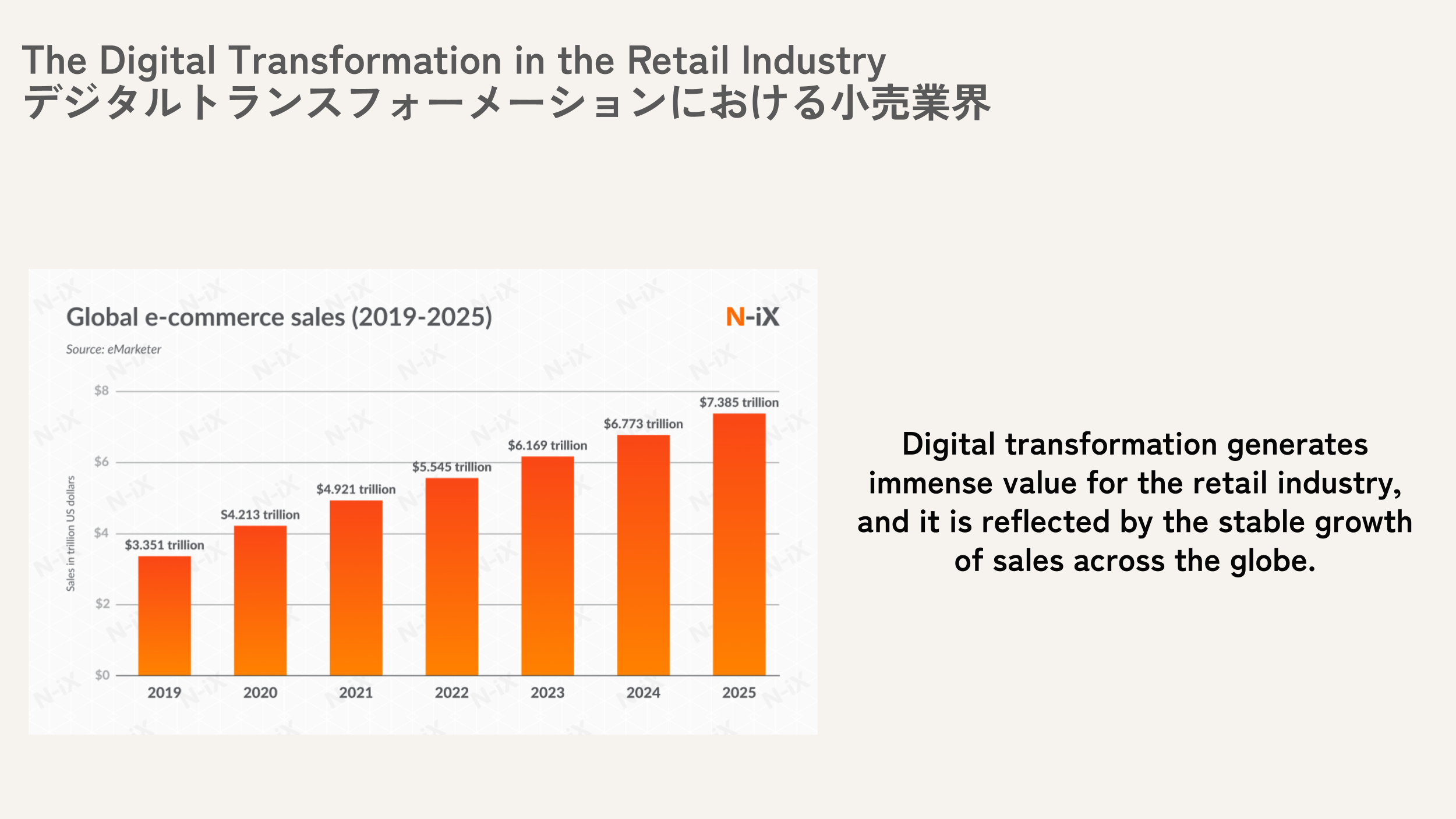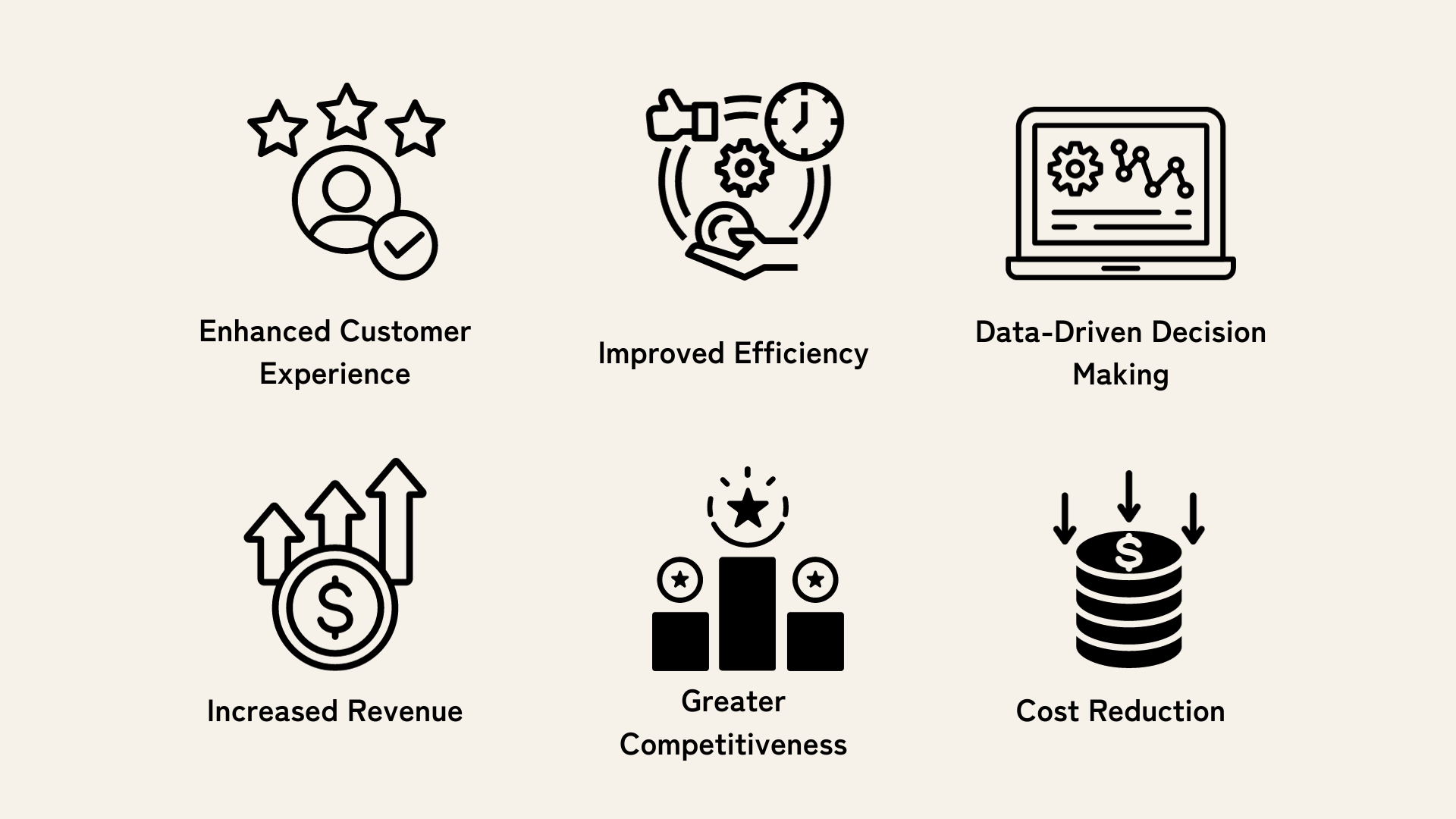Introduction
The retail industry is no stranger to change; it has consistently adapted to the needs, desires, and expectations of consumers.
Digital transformation has progressed from a buzzword to a business necessity.
According to Gartner, "By 2024, 25% of traditional large-chain retailers will reduce the number of stores, transforming to a De-commerce model leveraging AI, resulting in improved margins up to 5%."
This shift is largely driven by emerging technologies, changing consumer expectations, and the strategic importance of offering seamless, unified shopping experiences.
Moreover, recent global events such as the COVID-19 pandemic have further accelerated the necessity for digital transformation, with retailers increasingly needing to offer online shopping, fulfilment, and customer service options.
In light of these shifts, integrating a comprehensive digital strategy is now essential for survival and growth in the retail sector.
This in-depth exploration delves into the ongoing digital revolution in retail, discussing the importance of adapting to new realities, the key digital components in play, and strategies to kickstart your retail business' digital transformation journey.
What is Digital Transformation in Retail
Digital transformation in retail is the process of implementing digital technology across all aspects of the retail experience in order to improve operations, connect with customers on a deeper level, and respond to ever-evolving consumer demands.
The ultimate goal of digital transformation is to enhance customer experiences, streamline operational efficiency, and stay competitive in an increasingly online marketplace.
New digital technologies such as Artificial Intelligence (AI), Augmented Reality (AR), Internet of Things (IoT), mobile technologies, and cloud computing are driving this transformation in retail.
For instance, AR can be leveraged to facilitate 'try before you buy' shopping experiences, while AI and machine learning can personalize customer experiences, predict behavior, and manage inventory efficiently.
Key Components of Digital Transformation in Retail
Before diving into practical steps to digitally transform your retail business, it's important to understand the key components and aspects involved.
Here are the main elements that make up the digital transformation process in retail:
1. E-Commerce Platforms
The cornerstone of digital transformation in retail is the establishment and optimization of E-Commerce platforms.
Retailers invest in creating user-friendly websites and mobile applications to extend their reach to a global audience.
These platforms not only serve as virtual storefronts but also offer customers the convenience of shopping from anywhere at any time.

2. Mobile Applications
Mobile applications play a pivotal role in enhancing the customer experience.
Retailers develop feature-rich mobile apps to engage customers, provide personalized experiences, and facilitate smooth navigation through products and services.
Mobile apps often include functionalities like mobile payments, loyalty programs, and real-time notifications to keep customers connected.
3. Data Analytics
Data analytics is a game-changer in retail digital transformation. Retailers leverage advanced analytics tools to gather and analyze vast amounts of data, including customer behavior, preferences, and market trends.
Harnessing the power of data can help retailers gain valuable insights into customer preferences, buying habits, inventory management, and more.
Leveraging advanced analytics and AI-powered tools, businesses can make informed decisions that will positively impact their bottom line.
4. Supply Chain Management
Digital transformation efforts extend to the backend operations of retail businesses as well, particularly in the realm of supply chain management.
Employing IoT, AI, and advanced analytics can help streamline processes, improve efficiency, and optimize inventory management.
This includes efficient inventory management, timely restocking, and improved logistics to ensure products are available when and where customers demand them.
5. Point-of-Sale (POS) Systems
Digital transformation extends to the checkout process with the adoption of advanced Point-of-Sale (POS) systems.
These systems not only handle transactions but also integrate with inventory management and customer relationship management (CRM) systems.
This integration enhances transaction efficiency and provides valuable insights into customer interactions.
6. Customer Relationship Management (CRM)
Implementing CRM systems is essential for fostering strong relationships with customers.
CRM systems allow retailers to manage and analyze customer interactions, preferences, and feedback.
This leads to personalized communication, targeted marketing, and improved customer loyalty.
7. Artificial Intelligence (AI)
AI technologies are harnessed for various purposes in retail digital transformation.
From chatbots and virtual assistants to personalized recommendations, AI enhances efficiency and provides customers with personalized and engaging experiences.
AI also aids retailers in understanding and predicting customer behavior.
8. Augmented Reality (AR) and Virtual Reality (VR)
To enrich the online shopping experience, retailers integrate AR and VR technologies.
These technologies enable customers to virtually try on products, visualize how furniture looks in their homes, and experience products before making a purchase decision.
9. Digital Marketing
Digital marketing is a key component of retail digital transformation. Retailers leverage various digital channels, including social media, email campaigns, and online advertising, to reach their target audience.
Personalized marketing strategies based on customer data are employed to drive engagement and sales.
10. Omni-Channel Integration
Today's consumers move fluidly between online and offline channels, necessitating the need for seamless integration between the two.
Retailers implement features like click-and-collect, in-store pickups, and synchronized inventory to provide a unified experience.
An effective omni-channel strategy aims to provide a consistent and cohesive shopping experience, whether consumers are browsing in-store, online, or through a mobile app.
11. Cybersecurity Measures
With the increasing digitization of retail operations, ensuring the security of customer data and financial transactions is paramount.
Robust cybersecurity measures are implemented to protect against data breaches and maintain customer trust.
12. Cloud Computing
The adoption of cloud computing solutions has become integral to digital transformation.
Cloud technologies provide scalable infrastructure, accessibility, and cost-effective solutions for retail operations, enhancing flexibility and agility.
13. Internet of Things (IoT)
IoT devices are deployed for smart inventory management and real-time data monitoring.
These devices enhance visibility into the supply chain, enabling retailers to optimize operations and improve overall efficiency.
14. Blockchain Technology
Exploring the use of blockchain technology enhances transparency and security in transactions.
Retailers can leverage blockchain for supply chain traceability, ensuring authenticity, and building trust among consumers.
The Benefits of Digital Transformation in Retail
As the retail sector finds its footing in an increasingly digitized world, those companies that fully embrace and champion the digital transformation are seeing a range of significant benefits.
Let's examine these advantages more closely:
Enhanced Customer Experience
Digital transformation enables retailers to offer streamlined, seamless experiences across all touchpoints, thereby boosting customer satisfaction.
Technologies like AI and machine learning allow companies to personalize customer interactions, promote relevant products, and predict purchasing trends, all of which serve to enhance the overall customer journey.
Improved Efficiency
From streamlining supply chains to refining inventory management, digital transformation can vastly improve operational efficiency.
For instance, AI can optimize route planning for deliveries, and IoT technology can provide real-time insights about inventory levels and product demand.
Data-Driven Decision Making
Digital transformation provides retailers with a wealth of data that can drive decision-making processes.
Employing advanced analytics, businesses can uncover valuable insights about customer behaviors, preferences, and buying patterns, informing not just marketing strategy, but also product development and sales tactics.
Increased Revenue
When businesses make it easier for consumers to discover and purchase products, consumer spending typically increases.
By creating a unified, high-quality shopping experience and offering personalized suggestions, retailers can boost sales and foster customer loyalty, leading to greater repeat-business.
Greater Competitiveness
Retail businesses that resist digital transformation risk being outpaced by competitors. With consumers' rising expectations for efficient, personalized shopping experiences, companies must harness the power of digital transformation to stay competitive.
Cost Reduction
By digitizing and automating processes, businesses can reduce overheads, lower costs, and improve scalability.
For example, automated customer service chatbots can provide fast, efficient support, freeing up personnel for other tasks.

Strategies for Retail Digital Transformation
Now that we've discussed the key components of digital transformation in retail, let's delve into practical strategies to kickstart your digital journey.
#1 Define Your Vision and Objectives
Before embarking on a digital transformation journey, clearly articulate your vision and objectives.
Determine the key areas in which digitalization can add value to your business, improve customer experience, or optimize operations.
Setting specific, measurable, and achievable goals is critical in pushing your organization towards a successful digital transformation.
#2 Assess Your Current Digital Maturity
Understanding your current digital maturity level is vital in identifying the gaps that need addressing in your digital strategy.
Evaluate your organization's existing digital capabilities, including customer touchpoints, data infrastructure, and operational systems.
Identifying areas of improvement will help you prioritize your digital transformation efforts.
#3 Invest in the Right Technologies
Digital transformation in retail heavily depends on the integration of various technological components.
Invest in technologies like AI, machine learning, advanced analytics, and IoT that align with your specific goals, and facilitate robust, scalable platforms that enable seamless experiences across all channels.
#4 Foster a Digital-Minded Culture
People are at the heart of any successful digital transformation. Encourage a digital-minded culture within your organization by fostering collaboration, innovation, and agility.
Offer training programs, workshops, and incentives to help employees adopt new technologies, tools, and methodologies.
#5 Collaborate with Experts
Considering the complexities of a digital transformation, partnering with industry experts, consultants, or digital agencies could prove valuable.
Such collaborations can provide access to crucial expertise and insights that can guide and expedite your retail business's digital transformation journey.
#6 Track Progress and Iterate
Digital transformation is not a one-time project, but rather an ongoing journey with iterative improvements.
Monitor your progress by tracking key performance indicators (KPIs) related to your objectives, and use this data to inform decisions on further improvements or changes in course.
Stay informed about emerging technologies and trends to maintain a competitive edge.
Challenges in the Digital Transformation of the Retail Industry
While digital transformation empowers retailers to enhance customer experience and streamline operations, it also brings its own set of challenges.
Understanding these obstacles and adopting effective solutions is crucial for businesses to successfully navigate their digital journey.
Challenge 1: Integrating Online and Offline Channels
One common challenge for retailers is the integration of online and offline channels, a necessity for delivering a consistent omnichannel customer experience.
According to a PWC survey, 73% of all people pointed to customer experience as an essential factor in their purchasing decisions.
Solution: Implement a robust omnichannel strategy which seamlessly weaves the physical and the digital.
This strategy should ensure consistency across all touchpoints, enabling customers to switch between online and offline channels smoothly.
Challenge 2: Security Concerns
With the rise of eCommerce, security threats such as data breaches and cyber-attacks have become major concerns.
Retailers must secure sensitive customer and business data. Juniper Research indicates that the global cost of data breaches will reach $5 trillion by 2024.
Solution: Invest in robust cybersecurity measures, including encryption, multi-factor authentication, and secure payment gateways, to protect your business and build customer trust.
Challenge 3: Adapting to Rapid Technological Changes
The rapidly evolving retail technology environment can cause retailers to struggle with keeping up with the pace of change.
Technologies like AI, AR, VR, IoT, and big data are transforming customer expectations and industry standards.
Solution: Regularly auditing your technology infrastructure and investing in scalable, future-proof solutions can streamline this transition. Constant training and development can help staff to adapt to new technologies.
Challenge 4: Personalization at Scale
Customers expect personalized shopping experiences more than ever before. According to Epsilon, 80% of consumers are more likely to purchase from a brand that provides personalized experiences. However, achieving this at scale can be challenging.
Solution: Leverage AI and machine learning to analyze customer data and deliver personalized experiences.
CRM systems can help manage customer interactions at scale, ensuring individual needs are met.
Success Stories – Starbucks: Brewing Success with Digital Transformation
Since its founding in 1971, Starbucks has become synonymous with coffee culture worldwide. The company has continually embraced innovation, especially digital transformation, as a cornerstone of its business strategy.
Starbucks’ success story provides an inspiring roadmap for other companies aiming to transform their business digitally.
Emphasis on Mobile
Starbucks recognized early the potential of mobile technology to offer a seamless customer experience.
It launched the Starbucks Mobile App in 2009, introducing mobile ordering and payment capabilities.
The app also integrated the 'Starbucks Rewards Program', enticing customers to earn and redeem points for free beverages and food.
This strategy recognized the significance of customer convenience and speed of service, making Starbucks a standout among competitors.
Personalization through AI
Starbucks harnessed the power of Artificial Intelligence (AI) to deliver personalized customer experiences.
It developed an AI tool called the Deep Brew engine, which analyzes each customer's behavior, preferences, and order history.
Using this data, Deep Brew offers personalized suggestions, leading to a highly customized customer experience that builds brand loyalty.
Reinventing the Store Experience
Starbucks used digital technology to reinvent the in-store customer experience. It introduced various elements, such as Digital Order Manager (DOM), a tool that streamlines digital and in-person orders to ensure efficient, correct service.
The company also started piloting a feature called 'Barista Board', displaying real-time status of customer orders.
Harnessing Data Analytics
Starbucks has been leveraging data analytics to drive decision-making and streamline operations. It uses predictive analytics to manage inventory efficiently, minimizing waste while ensuring optimal product availability.
These strategies of digital transformation have helped Starbucks to elevate the customer experience, promote customer loyalty, increase efficiency, and stay ahead in an increasingly competitive market.
Starbucks' digital transformation success story is testament to the power of embracing technology to enhance business practices at all levels, from customer interaction to back-end operations.
Conclusion
Digital transformation has become essential in today's rapidly changing retail landscape.
By understanding the key components, implementing strategic initiatives, and learning from successful examples, retail businesses can embark on their digital transformation journey and leverage the benefits that come with it.
In doing so, they can ensure continued growth, customer satisfaction, and market competitiveness amidst a dynamic and evolving retail environment.








